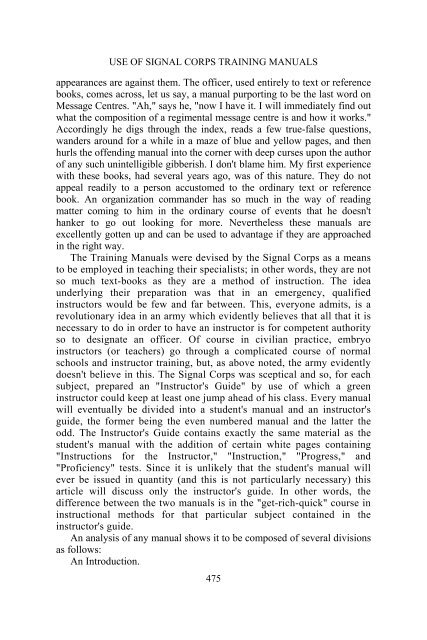september - october - Fort Sill
september - october - Fort Sill
september - october - Fort Sill
Create successful ePaper yourself
Turn your PDF publications into a flip-book with our unique Google optimized e-Paper software.
USE OF SIGNAL CORPS TRAINING MANUALS<br />
appearances are against them. The officer, used entirely to text or reference<br />
books, comes across, let us say, a manual purporting to be the last word on<br />
Message Centres. "Ah," says he, "now I have it. I will immediately find out<br />
what the composition of a regimental message centre is and how it works."<br />
Accordingly he digs through the index, reads a few true-false questions,<br />
wanders around for a while in a maze of blue and yellow pages, and then<br />
hurls the offending manual into the corner with deep curses upon the author<br />
of any such unintelligible gibberish. I don't blame him. My first experience<br />
with these books, had several years ago, was of this nature. They do not<br />
appeal readily to a person accustomed to the ordinary text or reference<br />
book. An organization commander has so much in the way of reading<br />
matter coming to him in the ordinary course of events that he doesn't<br />
hanker to go out looking for more. Nevertheless these manuals are<br />
excellently gotten up and can be used to advantage if they are approached<br />
in the right way.<br />
The Training Manuals were devised by the Signal Corps as a means<br />
to be employed in teaching their specialists; in other words, they are not<br />
so much text-books as they are a method of instruction. The idea<br />
underlying their preparation was that in an emergency, qualified<br />
instructors would be few and far between. This, everyone admits, is a<br />
revolutionary idea in an army which evidently believes that all that it is<br />
necessary to do in order to have an instructor is for competent authority<br />
so to designate an officer. Of course in civilian practice, embryo<br />
instructors (or teachers) go through a complicated course of normal<br />
schools and instructor training, but, as above noted, the army evidently<br />
doesn't believe in this. The Signal Corps was sceptical and so, for each<br />
subject, prepared an "Instructor's Guide" by use of which a green<br />
instructor could keep at least one jump ahead of his class. Every manual<br />
will eventually be divided into a student's manual and an instructor's<br />
guide, the former being the even numbered manual and the latter the<br />
odd. The Instructor's Guide contains exactly the same material as the<br />
student's manual with the addition of certain white pages containing<br />
"Instructions for the Instructor," "Instruction," "Progress," and<br />
"Proficiency" tests. Since it is unlikely that the student's manual will<br />
ever be issued in quantity (and this is not particularly necessary) this<br />
article will discuss only the instructor's guide. In other words, the<br />
difference between the two manuals is in the "get-rich-quick" course in<br />
instructional methods for that particular subject contained in the<br />
instructor's guide.<br />
An analysis of any manual shows it to be composed of several divisions<br />
as follows:<br />
An Introduction.<br />
475
















